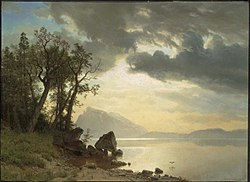Lake Tahoe's Sprites & Phantoms
- Cheryl Anne Stapp

- Jul 30
- 4 min read

Nestled among towering peaks, a body of sapphire blue water 12 miles wide by 22 miles long, Lake Tahoe is a place of dazzling natural beauty, a scenic wonder; a photographer’s paradise. Seemingly serene, the eons-old lake nevertheless shelters malevolent spirits, monsters, and ghosts.
Or so many believe . . . right up to the present day.
The Washoe people were the first humans there, Indians who lived in the Great Basin and the eastern Sierra. They spent winters in the lower valleys, and summers fishing, hunting, and gathering in the Lake Tahoe area, for 6,000 years or more. Over the centuries they carefully assessed the lake’s currents and upwellings; its gyres that could push and pull swimmers, its strong rip currents that could occur even on a calm day . . . and realized that other-worldly beings must live in its waters.
Tribal oral tradition taught that Water Babies dwelt at Cave Rock, at the lake’s southern end. These spirits were powerful beings capable of causing harm, or even death, to humans. That made Cave Rock a sacred place, where only healers were allowed to visit, for spiritual renewal. Before crossing the lake in canoes, or fishing on its shores, the Washoe made offerings of foodstuffs to the Water Babies, to protect them from drowning, or to ensure they caught many fish.
The Ong was a giant man-eating bird whose existence explained many things. Ong had the body of an eagle, the face of a human warrior, and wings longer than the tallest pine trees. The Ong’s powerful wing-beats could create winds strong enough to raise currents within the waters, and bend trees onshore when it flew by. The Washoe believed that anything caught in the lake’s pull would be carried to the beast’s nest—in the middle of the lake, on a spire that rose from the water—where its webbed feet trapped the unwary; drowning victims whose bodies were never recovered, were taken by the Ong. Luckily for mankind, the Ong was a cowardly creature that only attacked lone individuals who wandered too close. The Washoe took care not to travel, hunt, or fish alone on or around the lake.
A legend of more recent vintage is Tahoe Tessie, alleged to inhabit the depths of Lake Tahoe, a cryptid with similarities to the Loch Ness Monster said to dwell in a freshwater lake in the Scottish Highlands. Tessie was first “sighted” in 1865, by a tourist who reported seeing a massive serpent-like creature with a head 14 feet wide and a body over 600 feet long.
In the 1980s, multiple witnesses, all creditable, described a large, dark shape moving beneath the water’s surface, often creating a noticeable wake; in one report, a humped creature rocked the water at Zephyr Cove. In 2005, a former sheriff’s officer described seeing a large V-shaped wave cutting through otherwise calm waters; and tourists reported seeing a dark shape, with multiple humps, in the water near Tahoe Park Beach.
Lamentably, none of the modern-days Tahoe Tessie sightings were documented with photographs. Several theories have been proposed to explain her: it could be a giant sturgeon, a strange-looking, bottom feeding fish known to grow to large sizes, or natural phenomena such as water movements that create illusions of something beneath the waves.
Much more tantalizing to consider is the fact that Tahoe’s lowest depth of 1,645 feet could support a large predator that eludes detection. Be that as it may, today Tessie is a popular figure in local art and culture; mostly seen as the playful and friendly spirit as depicted in a 1980s bestselling children’s book series.
Then there is the ghost. Despite its surface area of 191 square miles, Lake Tahoe has only one island—Fannette Island in Emerald Bay—purportedly haunted by the spirit of Captain Richard “Dick” Barter, who lived there alone for a decade.
In 1863—sixty-plus years before millionairess Lora Knight built the still-standing Vikingsholm Castle—Barter was one of Tahoe’s first permanent residents, as the indigenous Washoe moved to lower elevations each winter. He didn’t own the property. A retired sea captain, he was hired as the caretaker for a wealthy mogul’s summer home on the lakeshore. Early on, he built himself a small cabin on tiny, deserted Fannette Island, possibly where Mrs. Knight’s tea house later stood. He lived there most of the time, dutifully rowing ashore to check on his employer’s five room villa, a place with no roads, no electricity, and no neighbors most of the year.
He did, however, enjoy company and a few libations now and then, rowing to the saloons in Tahoe City 16 miles north. It was on one of those trips, a night of intense cold (and Dick far from sober), that he capsized on his way back to the island, resulting in severe frostbite that forced him to amputate his toes. In 1870, San Francisco newspapermen, describing Barter as “an actual Robinson Crusoe, and most extraordinary,” publicized his many near-death experiences in the lake environs and gave him a new nickname, “Dick Them’s my toes Barter,” for his habit of showing the shriveled pegs to guests.
Captain Dick was 63 the year he capsized in the lake. Besides his cabin, he also fashioned a tomb, covered with a small Gothic chapel, on the island. Both structures are long gone but documented with 1870s photographs. On October 18, 1873, he was returning from Tom Rowland’s Lake House Saloon at the south end of the lake, when gale-generated waves pushed his dinghy into the rocks at Rubicon Point, smashing the craft to pieces. Captain Dick drowned in 1,400 feet of water.
His body was never recovered, but on October nights, when a cold mist settles on Emerald Bay, some say that you can see his ghost wandering about on Fannette Island.




Comments